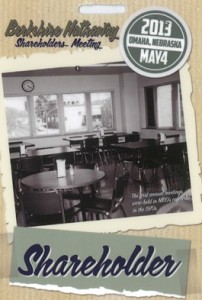 The Chairman and I recently went to the Berkshire Hathaway AGM in Omaha Nebraska. A fantastic weekend, very inspiring. To travel across the globe with my father to listen to two of the most successful investors speak will be something I will remember for a very long time.
The Chairman and I recently went to the Berkshire Hathaway AGM in Omaha Nebraska. A fantastic weekend, very inspiring. To travel across the globe with my father to listen to two of the most successful investors speak will be something I will remember for a very long time.
Below are some notes taken during the AGM and with discussions with management of various BRK investments during the day.
Berkshire Hathaway AGM, Omaha, Nebraska, Saturday 4th May 2013.
- 3 hours of Q&A, a 1 hour break, another 3 hours of Q&A, followed by the AGM.
- There were three financial journalists leading the Q&A being Carol Loomis – Fortune, Becky Quick – CNBC, and Andrew Ross Sorkin – The NY Times.
- The second panel was made up of three analysts who follow BRK. Insurance analyst, Cliff Gallant of Nomura Securities, Jonathan Brandt of Ruane, Cunniff & Goldfarb and a token bear on the stock, shorting, hedge fund expert Doug Kass of Seabreeze Partners.
- Berkshire Hathaway (BRK) is now the 5th largest listed company in the world, behind Apple Inc, Exon Mobil, Microsoft, Apple Inc, Google Inc and Microsoft Corporation. Munger put it quite simply, “Size matters, it does”. In the current Fortune 500 rankings BRK is the 5th largest company by Revenue, behind three oil/petroleum distributors and the world’s biggest retailer Wal-Mart.
- Insurance profits for the 1st Quarter were up, with Auto Insurance a stand out. This commentary combined with continual sales growth in US pick up’s, it’s no wonder ARB Corporation want to get their teeth into this market.
- BNSF Railway (the second-largest freight railroad network in North America) was up 3.8%, driven by increased oil transportation as well as a general pick up in goods (namely Auto and Building/Construction). “The USA produces 5m barrels of oil per day”.
- One of BRK early barometers of how the US economy is going is measured by car movements on their railroad system. With a pickup in rail movements both Buffet and Munger were generally quite bullish on the state of the US economy, passionate, and maybe a little one eyed (there is nothing wrong with that). He looks at this data religiously each and every week.
- “What has happened in the economy has taken everybody by surprise”. However Buffet was then soon to encourage the audience to take out a fixed housing loan for 30 years and invest now, “Banks want loans”.
- “When rates first go down, people are skeptical, but after a while they start to drive prices. Interest rates are to asset prices what gravity is to the apple, they power everything”.
- “The Fed needs to push up inflation, this will help reduce our debt, and it will also lift the dollar, confidence, securities and housing”.
- “Lower interest rates have obviously helped, better buying opportunities, easier to borrow”. They said that you shouldn’t just take the low interest rates for granted (they don’t expect them to rise all of a sudden either). They used the Japanese market as an example of rates coming down and staying down. They hoped the Fed were using the 20 years of depressed markets in Japan as a case study for the current US position.
- Despite the low rate environment Munger thought that “Modern prices are not cheap”. “Paying up for an extraordinary business is not a mistake and you are going to see less great businesses at good prices in the future”.
- They made comment that they paid more for Heinz than they would have liked. They paid 20X for GEICO when they bought it. But it had great management. This was a theme mentioned over and over during the day. Good Management. Some of the best acquisitions they said they have made are bolt on’s to the existing businesses. They already have the management, proven management that is familiar to Buffet and Munger so they can be left to run that business increase earnings and they don’t have to spend too much more time on it.
- “Good management will have low costs, build a brand and have a quality product”.
- “Having capital is one thing, having the ability to deploy that capital is another”. One of BRK’s competitive advantages is that they are not a competitor when purchasing a company. This allows sellers to approach them without fear. BRK currently has approx $50bln in “float” (cash) not earning anything in interest. BRK couldn’t find anything of size to invest in during the last financial year.
- “You have to understand the company; what its competitive advantage is and the reason for it, don’t just rely on the math”.
- BRK mainly seem to focus on volume and business that is able to target the US’s scale. Many companies held in their portfolio target this, focusing on price points for the middle to low income earner (as well, in many cases, the top end). Heinz, Mars, Coca Cola, Brooks, Dairy Queen, Nebraska Furniture Mart, Justin Boots, Wrigley, Fruit of the loom, Banks, Financial Services, Insurance.
- “When valuing, ask yourself what is this place going to look like in 5 years from now”.
- “Don’t get excited when other people are getting excited. You can’t afford to go along with the crowd”.
- “Do not pay any attention to macro-economic conditions or forecasts. Why worry about what you can’t predict? Value the replacement value of each company.”
- “Do not listen to predictions”.
- “If you have doubts, then forget it”.
- Buffet and Munger got quizzed a few times on the short-term-ism of today’s markets dominated by short selling and high frequency trading…”Charlie and I don’t like trading agony for money, but for those who do, we wish you well”.
- Buffet and Munger both strongly believe (and are probably a bit one eyed) that China and the US will become the two economic super powers in the future. “There is no threat to the US being the world’s reserve currency”.
- When asked on succession planning, Munger at 89 years of age said “When we go and new management is running this company, don’t go and do something stupid and sell the shares”.
- These were my favorite inspirational one liner’s from the day… “Competition is one of the more difficult objects to get over as an investor, plug along, work hard at what you like doing”… “To attract money you should deserve the money, you need to prove the track record and ensure it wasn’t luck”…. “The game of life is a game of everlasting leaning…if you want to win”.
Main Company Contact Notes below:
Acme Brick Company
Britt Stokes, General Manager
- Established in 1891, currently the largest manufacturer of bricks in the US.
- 25 brick plants, mainly located in central and southern US.
- Plants fitted out with robotics and automation
- 60+ company-owned sales locations
- Acme uses gas fired kilns, which will place the company well for the future given the US gas supply. Having said this they are seeing that many power generators are still leaving their access to coal open; duel fuel. If the price of gas gets too uneconomical they will be able to switch back to coal.
- “Life Cycle Assessment” (LCA) is expected to assume a greater role in house design and construction. Acme Brick have introduced the industry’s first 100 Year Limited Guarantee for Homebuyers on their products.
- Housing is beginning to pick up. 1.2 million Housing Starts is the number that appears to be the magic figure for the building industry.
Justin Boot Company
Herb Beckwith, CFO
- Established in 1879.
- Business travelling well. Economy for this company seems robust given the location of main distribution outlets, mass of population and quality reliability of product.
- Currently sourcing hide from Asia to minimize cost of production, However all production will continue to be done in the US.
- Cost of landing a pair of Justin Boots to Australia is estimated at $0.85. Boot prices ranged from $105 through to $550.
- Sold over 1,300 pairs of boots at 3:30pm with 2 hours of the exhibition remaining.
Nebraska Furniture Mart
Ron Blumkin, President
- NFM aims for a 5% NPAT target year on year.
- Have only had one year without sales growth since they started (2009).
- They show all their managers the figures every month.
- They are a destination ‘bricks and mortar’ business.
- The customers come to their store with all the information about products already (usually from the internet). The internet helps them with sales as it shows customers that they are the best prior to them coming on site.
- Expansion into Texas is expected in the near term with an estimated retail, pick up and distribution facility that will expand over 100 acres!
I hope you found their quotes and comments as interesting as I did.
Tom Millner
May 2013
